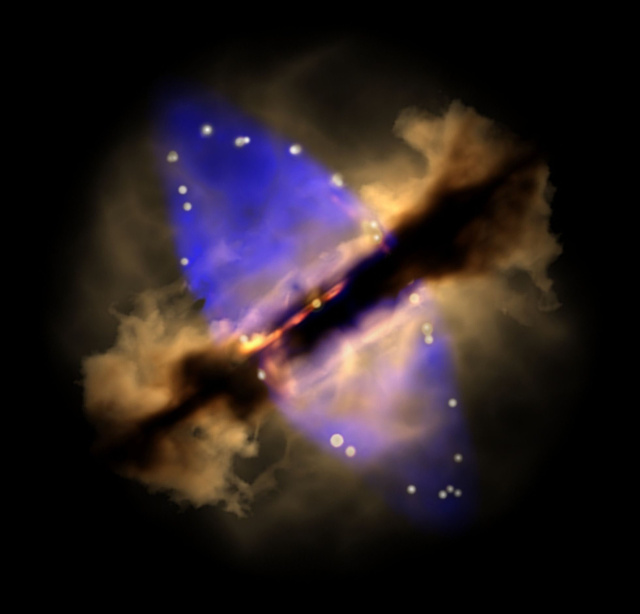
Most astronomical events, with the exception of the explosive ones, take place over long periods of time. Thankfully the Universe is big, so we can reconstruct most of them by looking at many examples that collectively represent a timeline. It's an exception to be able to watch something develop in real time.
But an international team of researchers may have done just that. With a pair of observations 18 years apart, they've spotted what appear to be large jets of material erupting from a massive protostar. The findings provide information that can help inform our models of the formation of massive stars.
Star formation is a careful balancing act. The force of gravity that pulls material together is counteracted in part by the energy built up as the material collapses and compresses. That energy causes what's termed "radiation pressure," which pushes against the infalling material. To actually form a star, some of that heat has to be shed.
For many stars, it's shed through the formation of jets of material at the poles. Jets of this sort are a common feature of systems that are drawing in material, from forming stars to supermassive black holes. Typically, they're associated with accretion disks, belts of material that orbit the body in question. The material in the disks is thought to help power the jets, which are organized by the magnetic fields of the body that's drawing in matter.
In 1996 when astronomers first looked at the system at issue, W75N(B)-VLA 2, what they saw was essentially a hot sphere. The center of the sphere was a protostar, one that we now know is at least six times the mass of the Sun. It's separated from another forming star by about 900 Astronomical Units (roughly 30 times the distance between the Sun and Neptune).
The sphere was accompanied by naturally occurring masers, the microwave analog of a laser. These are created by shockwaves that form as the material being shed through the jets of the growing protostar slams into water molecules in the surrounding cloud. The jets, however, were relatively small and not especially organized; the masers were arranged in a more-or-less spherical shell.
When follow-up observations were performed in 2014, however, the sphere of hot material had been radically reshaped. In its place was an elongated lobe, one that lined up with the star's magnetic field. The authors refer to the process that drove this change as collimation, which essentially means that the previous spherical outflow has been reorganized into a jet of material all heading roughly in the same direction. The jets, rather than being minor features, had elongated by 170 astronomical units and become key components of the forming star. The authors estimate that the area where masers are present has expanded at a rate of 30km a second in the intervening years.
As the authors put it, "All these observations suggest that we are observing in 'real time' the transition from an uncollimated outflow to a collimated outflow during the early life of a massive star." Modeling of the system suggests that an accretion disk of some sort may have formed.
All of which is somewhat surprising, as an accompanying perspective makes clear. Massive stars are extremely hot and dense, which cuts down on their convection. The convection in turn is what's thought to create the magnetic fields of the stars. As a result, bright, massive stars have relatively weak magnetic fields. The author of the perspective, Melvin Hoare, suggests that the new results may indicate that massive stars may go through a period early in their history where they expand to lower densities, allowing convection to take place.
Given we now know of at least one massive star that is undergoing dynamic changes as it forms, we may be in a better position to test some of these models in the near future.
Science, 2015. DOI: 10.1126/science.aaa7216 (About DOIs).
reader comments
32